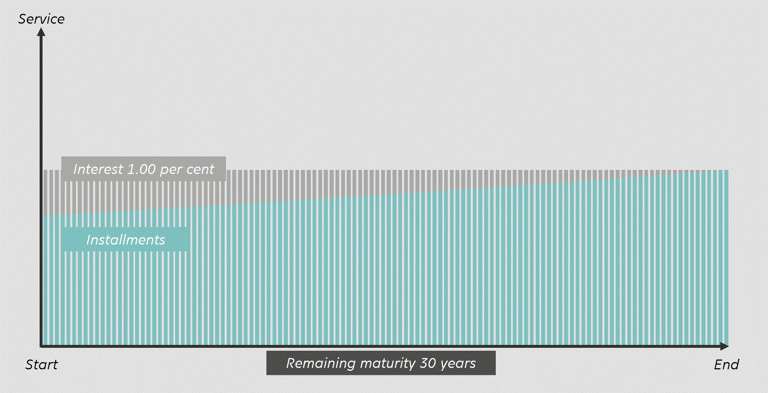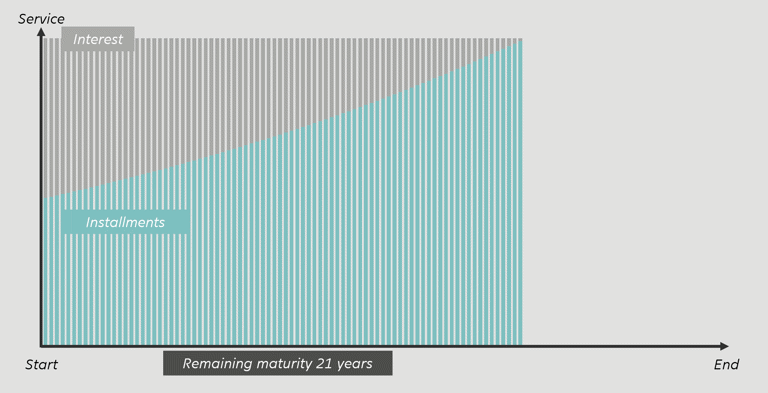Statistical news focuses on the latest figures and trends in Danmarks Nationalbank’s statistics. Statistical news is targeted at people who want quick insight into current financial data.
Homeowners are still paying less in installments on their mortgage debt
In 2024, homeowners paid an average of kr. 18,750 in ordinary installments per million in mortgage debt. This is kr. 950 (4.8 per cent) less than in 2023, and kr. 5,700 (23.2 per cent) less than in 2020, when installment payments most recently peaked. How much homeowners currently repay on their mortgage debt is not only a result of whether the debt is with installments and how large the debt is. Interest rate developments and the remaining maturity of the debt also play a crucial role, with rising interest rates in particular contributing to the decline in homeowners' installment payments in recent years.
Figure 1: Homeowners' ordinary installments have declined since 2020
Note:
Ordinary installment payments on loans from mortgage banks measured in relation to the outstanding debt at the beginning of the year, nominal value. Converted to ordinary installments in kr. per year per million borrowed. Danish private customers (employees, pensioners, etc.)
Despite the fact that homeowners have increased their debt with installments since the fall of 2023, so that they are now paying installments on both more mortgage debt and a larger share of their total mortgage debt, homeowners are paying less in installments overall per mortgage million borrowed. The share of homeowners' total mortgage debt that is with installments was 52.6 per cent at the end of 2024. Despite the increase since the fall of 2023, this is still considerably lower than in 2020, when the share most recently peaked at around 55 per cent.
Higher interest rates, longer remaining term, lower installments
Since interest rate increases accelerated in 2022, the average interest rate on homeowners' mortgage debt with installments has tripled, corresponding to an increase of 1.8 percentage points. In isolation, the interest rate increase has meant that the ordinary installments on homeowners' debt have been reduced by 20 per cent.1 This is because the service on homeowners' mortgage loans with installments consists of interest and administration fees as well as ordinary installments. When the interest payment increases, the installment profile on the debt will typically become steeper. This means that the installments at the beginning of the loans maturity are lower and make up a smaller part of the service than otherwise.
Figure 2: Higher interest rates lead to a steeper installment profile

Note:
The figure shows a stylized example of how the service (interest and installments) on a mortgage loan changes when the interest rate changes without changing the remaining maturity. For the sake of simplicity, the example ignores administration fee payments, which are added to the service.
Higher interest rates also mean that the length of the remaining maturity of the mortgage debt has a greater impact on how much is paid in installments. This is because mortgage loans with installments are typically annuity loans, where installments constitute a smaller part of the service at the beginning of the loan maturity and increase as the remaining maturity decreases. At the end of 2024, the average remaining maturity of homeowners' mortgage debt with installments was 23 years and 10 months. The remaining maturity has been fairly stable over the past 5 years and has only varied by 5 months.2 The stable remaining maturity is an expression of the fact that the natural decrease in the remaining maturity, as time goes by, has largely been offset by new and restructured mortgage loans with longer remaining maturity and loans where the remaining maturity has been extended, for example in connection with interest rate adjustments.
Figure 3: Longer remaining maturity leads to a flatter installment profile

Note:
The figure shows a stylized example of how the service (interest and installments) on a mortgage changes when the remaining maturity changes. For the sake of simplicity, the example ignores administration fee payments, which are added to the service.
Not all homeowners pay less installments
There is a close connection between the types of homeowners' loans and how much they pay in ordinary installments. Many homeowners with variable-rate loans have received a new and typically higher interest rate on their loans, if they have been adjusted since 2022. These homeowners are now paying significantly more in interest on their loans than before. For many homeowners, this also means that they are paying less in installments.3
Homeowners with fixed-rate loans, on the other hand, are guaranteed a fixed interest rate over the entire maturity of the loan. Those who have maintained their loans will therefore not have felt the consequences of the rising interest rates on the size of their ordinary installments.
Homeowners who have restructured their fixed-rate loans, on the other hand, will typically have received a higher interest rate and, as a consequence, will pay less in installments than before the restructuring. If, in connection with the restructuring, the homeowners have extended the remaining maturity of the debt or reduced the remaining debt, this will also contribute to the ordinary installments being smaller.
Extraordinary reduction of outstanding debt
Homeowners can choose to reduce their mortgage debt exceptionally in connection with loan restructuring or via extraordinary installments. However, the scope of extraordinary installments is relatively limited compared to ordinary installments. Nevertheless, the higher interest rate level in recent years has made it more attractive for homeowners to make extraordinary installments on their mortgage debt and thus reduce their interest payments. In 2024, an average of kr. 1,850 was paid in extraordinarily installments per million borrowed in mortgage loans, compared to kr. 800 in 2020.
The development of interest rates has had a large impact on extraordinary reductions in outstanding debt through loan restructurings of fixed-rate mortgage debt – i.e. through early repayment of loans significantly below the rate of 100 and taking out a new loan with a lower outstanding debt. Particularly in 2022 and 2023, a number of homeowners chose to reduce their outstanding debt in connection with loan restructuring. The reduction corresponds to DKK 12,400 in 2022 and almost DKK 8,000 in 2023 per million borrowed in mortgage loans.
Figure 4: Homeowners have not only reduced their mortgage debt via ordinary installments
Note:
Ordinary installment payments and extraordinary installments on loans from mortgage banks, as well as reduction of remaining debt in connection with loan restructuring, measured in relation to the remaining debt at the beginning of the year, nominal value. Converted to ordinary installments in kr. per year per million borrowed. Danish private customers (employees, pensioners, etc.)
